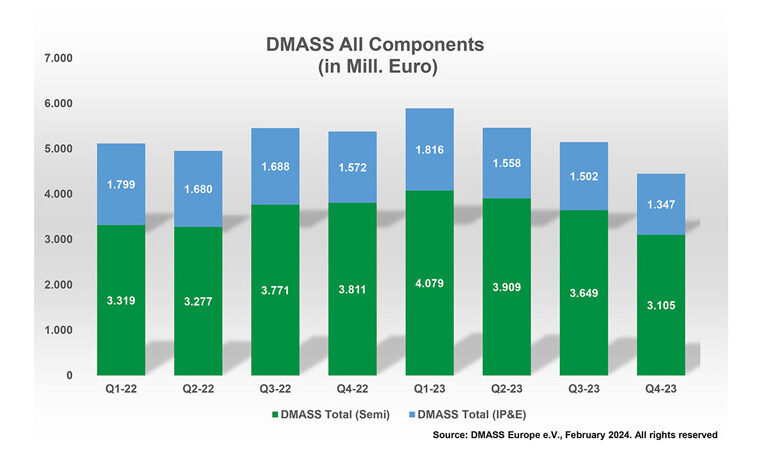The European components distribution market declined in Q4, ending a long period of growth, according to DMASS.
Distributors and manufacturers in DMASS reported consolidated sales of 4.45 billion Euro in Q4/2023 (-17.3% compared to Q4/22).
Semiconductors dropped to 3.1 billion Euro (-18.5%), IP&E (Interconnect, Passive and Electromechanical) components declined by 14.3% to 1.35 billion Euro.
For the total year 2023, DMASS reported consolidated sales of 21 billion Euro (+0.2%), beating former record 2022 by a narrow margin. All the 2023 growth came from semiconductors (+4%), while IP&E dropped by 7.7%.
Hermann Reiter, chairman of DMASS commented: “The expected slowdown was softened by a very good first half of 2023, resulting in another record year. Admittedly, distribution revenues were driven by orders and sales brought forward from 2024, inflating 2023 results significantly. The consequence is that we are now facing a market contraction that bring the business back in line with long-term growth averages.”
“Our hope for 2024 resides with an overall market upside through the hype around artificial intelligence that could pull the entire market along,” added Reiter. “For Europe in general and components distribution and their customers in particular this effect will occur at best towards the end of 2024. The focus of distributors now must be on helping our customers to develop new markets and accelerate innovation opportunities. Electronics will remain the driving force of economical and societal transformation.”
Semiconductor distribution sales in Europe shrank by 18.5% to 3.1 billion Euro. Regionally, no country remained positive, with major differences between regions.
Of the major markets Italy recorded a 23.7% decline to 249 million Euro. Germany spiralled 21.5% to 860 million Euro. France sales fell 11.3% to 228.5 million euro.
The UK market slipped 4.5% to $231 million Euro. Ireland was the outlier recording growth 6.8% to 27.5 million Euro.
Nordic region sales of 255.6 million Euro were down 22.6%.
Microprocessors bucked the trend amongst the products growing 17.6%.
The rest declined between low single-digits and over 40%. Standard logic slumped 40% to 33.4 million Euro. Discretes slid 35.5% to 139.6 million Euro. Power dropped 13.6% to 361.7 million Euro. Analogue, the largest category was down 22.4% to 809.5 million Euro.
IP&E fared no better as the slowdown continued in Q4. The IP&E distribution market declined by 14.3% to 1.35 billion Euro in Q4. The slowdown in all 3 product groups remained in the lower double digits – passives fell 18% to 510.7 million Euro, power supplies slipped 12.8% to 99.7miilion Euro and electromechanical products dipped 11.72% to 737 million Euro.
DMASS Chairman Hermann Reiter concluded: “As clearly as the trend may point downwards now and as much as this was visible and to be expected for quite some time, we must be careful with predictions. Why? The challenges and opportunities in this market have become less readable than in the past and the dynamics today are influenced by political as well as technological factors that are by nature disruptive, possibly in both directions. Unpredictability notwithstanding, we are convinced that distribution will remain the stabilizing and balancing force in the market.”
Microprocessors bucked the trend amongst the products growing 17.6%.
The rest declined between low single-digits and over 40%. Standard logic slumped 40% to 33.4 million Euro. Discretes slid 35.5% to 139.6 million Euro. Power dropped 13.6% to 361.7 million Euro. Analogue, the largest category was down 22.4% to 809.5 million Euro.
IP&E fared no better as the slowdown continued in Q4. The IP&E distribution market declined by 14.3% to 1.35 billion Euro in Q4. The slowdown in all 3 product groups remained in the lower double digits – passives fell 18% to 510.7 million Euro, power supplies slipped 12.8% to 99.7miilion Euro and electromechanical products dipped 11.72% to 737 million Euro.
DMASS Chairman Hermann Reiter concluded: “As clearly as the trend may point downwards now and as much as this was visible and to be expected for quite some time, we must be careful with predictions. Why? The challenges and opportunities in this market have become less readable than in the past and the dynamics today are influenced by political as well as technological factors that are by nature disruptive, possibly in both directions. Unpredictability notwithstanding, we are convinced that distribution will remain the stabilizing and balancing force in the market.”











Comments are closed.